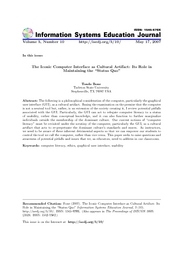Volume 5
Volume 5, Number 10 |
May 17, 2007 |

|
Tonda Bone
|
Abstract: The following is a philosophical consideration of the computer, particularly the graphical user interface (GUI), as a cultural artifact. Basing the examination on the premise that the computer is not a neutral tool but, rather, is an extension of the society creating it, I review potential pitfalls associated with the GUI. Particularly, the GUI can act to relegate computer literacy to a status of usability, rather than conceptual knowledge, and it can also function to further marginalize individuals outside the membership of the dominant culture. Our current notions of “computer literacy” must be revisited under the scrutiny of the computer, particularly the GUI, as a cultural artifact that acts to re-perpetuate the dominant culture’s standards and mores. As instructors, we need to be aware of these inherent detrimental aspects so that we can empower our students to control the tool we call the computer, rather than vice versa. This paper seeks to raise questions and awareness of potential pitfalls and issues that we, as educators, need to address in our classrooms.
Keywords: computer literacy, ethics, graphical user interface, usability
Download this issue: ISEDJ.5(10).Bone.pdf (Adobe PDF, 10 pages, 519 K bytes)
Preview the contents: Bone.j.txt (ASCII txt, 30 K bytes)
Recommended Citation: Bone (2007). The Iconic Computer Interface as Cultural Artifact: Its Role in Maintaining the “Status Quo” Information Systems Education Journal, 5 (10). http://isedj.org/5/10/. ISSN: 1545-679X. (A preliminary version appears in The Proceedings of ISECON 2005: §3524. ISSN: 1542-7382.)